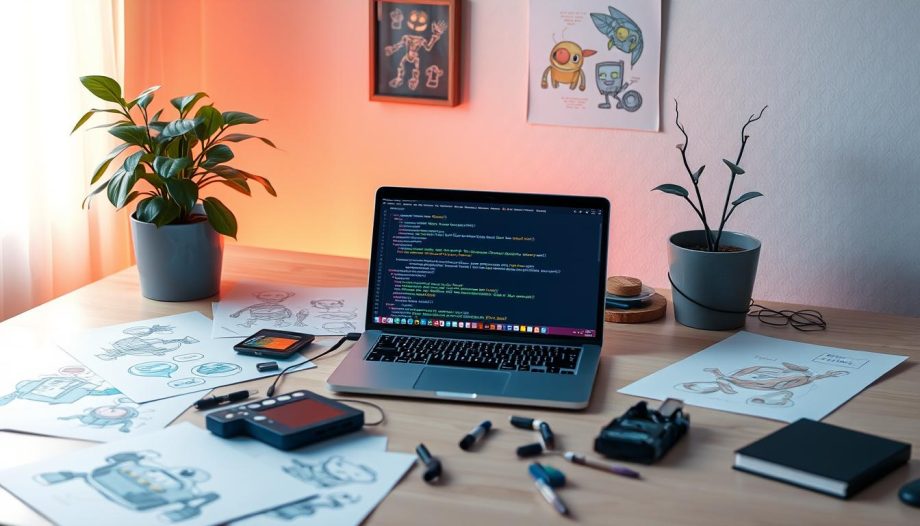Welcome to our comprehensive guide on chatbot creation! In this HTML chatbot tutorial, we will explore how to build an interactive website assistant that can enhance customer engagement on your platform. With the rise of digital communication, having a chatbot on your site offers benefits like 24/7 availability and improved user experience. Together, we will dive into the process of coding chatbots, discussing the essential technologies involved and what you can expect from this journey in chatbot development.
Understanding the Basics of Chatbots
In this section, we will explore the fascinating world of chatbots, helping us understand their core functions and the value they bring to web development. A chatbot is a software application created to imitate human conversation through text or voice, making it a powerful tool for businesses and developers alike.
What is a Chatbot?
The chatbot definition includes various applications, from simple rule-based responders to complex AI-driven systems. These automated systems can engage with users effectively, enhancing interactions on websites and applications. The types of chatbots can broadly be classified into:
- Rule-Based Chatbots: Operate on predefined rules and logic.
- AI-Driven Chatbots: Utilize machine learning to improve responses over time.
- Hybrid Chatbots: Combine the strengths of both rule-based and AI-driven approaches.
Examples of popular chatbots include Facebook Messenger Bot and Drift, showcasing how these systems can enhance user engagement and streamline customer support.
Importance of Chatbots in Modern Web Development
Chatbots have become essential user engagement tools in today’s digital landscape. Their benefits include improved customer service, round-the-clock availability, and effective data collection, enabling businesses to understand user needs and preferences better. In terms of web development tools, integrating chatbots into websites can lead to significant improvements in user experience and operational efficiency.
How to Make a Chatbot in HTML
To create an engaging chatbot using HTML, we first need to ensure our development environment configuration is suitable for our project. This involves choosing a reliable code editor and a web browser for testing. Once we set up our workspace, we can proceed with crafting the HTML structure needed for our chatbot, followed by applying CSS styling for chatbots to enhance its visual appeal.
Setting Up Your Development Environment
Before diving into the coding process, we must establish an effective development environment. A popular choice for a code editor is Visual Studio Code, which offers a range of extensions that can support our HTML chatbot setup. Pairing this with a modern web browser like Google Chrome will allow us to test and debug our chatbot as we develop it.
Creating the HTML Structure
Next, we begin developing the HTML structure that underpins our chatbot. This structure typically includes:
- An input field for user messages.
- A button to send messages.
- A display area for chat history.
The creation of these elements lays a solid foundation for our chatbot’s functionality.
Integrating CSS for Styling
Once we have our HTML structure in place, the next step is applying CSS styling for chatbots. This step enhances our chatbot’s appearance and ensures it matches the design of our website. We can use various styles to modify elements like background color, font size, and button styles, ultimately creating an attractive user interface.

Enhancing Your Chatbot’s Functionality
To create an engaging user experience, we should consider integrating JavaScript for chatbots. This powerful scripting language allows us to develop interactive chatbot features that can respond to user inputs in real-time. By utilizing JavaScript, we can seamlessly add events and animations to our chatbot, ensuring that it feels interactive and lively.
Using JavaScript for Interactive Features
JavaScript provides numerous tools that can enhance the conversational flow of our chatbot. For instance, we can implement features such as:
- Typing indicators to simulate real-time responses.
- Quick reply buttons for easier user interaction.
- Notifications for updates or actions performed.
These interactive chatbot features create a more engaging experience, helping to keep users interested and facilitating smoother conversations.
Connecting to a Backend for Data Processing
Incorporating backend integration is crucial for managing user requests efficiently. A backend service can handle complex processes like server-side processing and data storage. Here are some benefits of connecting our chatbot to a backend:
- Storing user interaction history to improve personalization.
- Accessing APIs to extend functionality beyond basic responses.
- Implementing complex algorithms for better decision-making.
Understanding JavaScript coding tips for API integration can assist us in achieving seamless communication between our chatbot and the backend. This connection elevates the bot’s intelligence and responsiveness, ensuring that users receive relevant and timely information.

| Feature | Description | Benefits |
|---|---|---|
| Typing Indicators | A visual feedback mechanism indicating that the bot is processing a response. | Enhances engagement by creating anticipation. |
| Quick Replies | Buttons that allow users to respond quickly without typing. | Improves efficiency and keeps the conversation flowing. |
| Backend Integration | Connecting the chatbot to a server for data processing and storage. | Offers more robust capabilities and personalized experiences. |
Testing and Deploying Your Chatbot
As we prepare to launch our chatbot, effective chatbot testing procedures are crucial to ensure everything functions smoothly. We should start by implementing thorough user testing, involving real users who can provide valuable insights into how the chatbot performs in real-world scenarios. This feedback is essential, as it creates feedback loops that allow us to identify areas for improvement. Whether it’s fine-tuning responses or enhancing navigation, our goal is to provide an optimal user experience.
Once we’ve collected and analyzed feedback, we can move on to our deployment strategies. It’s vital that we deploy our chatbot on a reliable platform that supports its features. Ensuring that our backend is robust and can handle concurrent users will help us improve our chatbot performance optimization. Additionally, we should monitor user interactions continuously to spot any issues post-deployment swiftly.
Finally, let’s remember that the work doesn’t end once our chatbot is live. Ongoing monitoring and updates are necessary to adapt to changing user needs and technologies. By maintaining an iterative approach, we can keep enhancing our chatbot’s capabilities, ensuring it remains useful and engaging for our users.

